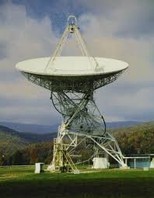The Tatel Telescope
Introduction
Text-to-speech Audio
Images
The Tatel Telescope, NRAO. It is called 85-1 because it was the first 85-foot telescope constructed at Green Bank.

Backstory and Context
Text-to-speech Audio
The National Radio Astronomy Observatory established a site at Green Bank, West Virginia without a radio telescope. The kit needed to construct their first radio telescope arrived in summer of 1958 and finished construction in early 1959. Named after Howard Tatel, who worked for the Carnegie Institute Department of Terrestrial Magnetism, creating the initial design of the telescope, making it both more precise and cheaper to build. Tatel did not see the finished telescope because of his death in 1957, while the first telescope was still under construction. Green Bank’s 85-1 telescope would be named in his memory on October 16, 1958, during its dedication. The Tatel Telescope gave astronomer brighter and more accurate information on radio objects in space previously available. Including objects located within the solar system, such as the surface temperature of the moon and studies of Jupiter’s radiation belt. The telescope was only expected to work for twenty years, despite this, the telescope continued to function and remained in use until October 2000.
February 13, 1959, the Tatel Telescope began its 24-hour examination of the universe, examining the brightest known radio objects, including supernovas and galaxies. Astronomer Frank Drank used this telescope to create a detailed map of the Milky Way galaxy. Discovering a never seen complexity of radio waves coming from the galaxy’s core. In 1960 for two months Drake turned the telescope towards two nearby sun-like stars, Tau Ceti and Epsilon Eridani, searching for possible signals from an alien civilization. The project used a 21-cm line of hydrogen, “the most common radio signal in the universe” to search for radio transmissions with minimal interference. They did not find any evidence of alien life near either star, but during research, they received a false signal caused by airplanes. After the construction of two additional 85-foot telescopes using the same design as the Tatel Telescope, these three telescopes combined to become the Green Bank Interferometer, using multiple telescopes to gain a better perception of the target. From 1978 to 1996 the GBI was used to study the Earth’s rotation and a variety of radio signals. Then from 1996 to 2000, its focus shifted to studying gamma and x-rays of stars with partial funding from NASA. The GBI would continue its work until October 6, 2000, but the individual telescopes remained in operation focusing on other projects they were contracted to perform.
Sources
“Tatel Telescope”, The National Radio Astronomy Observatory, last modified June 2000, accessed July 15, 2018, http://www.gb.nrao.edu/fgdocs/tatel/tatel.html
“Tatel”, The National Radio Astronomy Observatory, accessed July 15, 2018, https://public.nrao.edu/telescopes/tatel/
“Green Bank Interferometer”, The National Radio Astronomy Observatory, accessed July 15, 2018, https://public.nrao.edu/telescopes/green-bank-interferometer/
